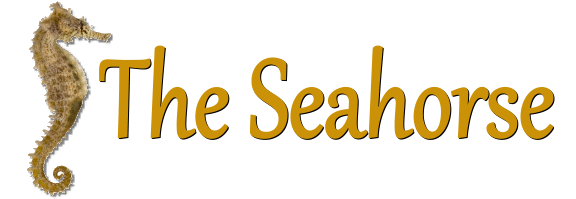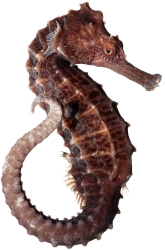 Seahorses are one of the most instantly recognizable groups of fish. Possessing swim bladders to remain buoyant in the water and utilizing gills to breathe, these fish are covered in sturdy armor-like plates. This tough, bony surface makes them hard for other fish to digest, which means they don't have many natural predators.  Having a head and neck suggestive of a horse, with long snouted heads, seahorses also have an upright posture and a curled prehensile tail. Seahorses range in size from 1.5 to 36 cm. They have thin skin stretched over a series of bony plates, which are arranged in rings throughout their bodies. A seahorse has a flexible, well-defined neck, which is highly unusual for a fish. It also has a crown-like horn on its head, called a 'coronet', which is distinct for each species of seahorse.
Having a head and neck suggestive of a horse, with long snouted heads, seahorses also have an upright posture and a curled prehensile tail. Seahorses range in size from 1.5 to 36 cm. They have thin skin stretched over a series of bony plates, which are arranged in rings throughout their bodies. A seahorse has a flexible, well-defined neck, which is highly unusual for a fish. It also has a crown-like horn on its head, called a 'coronet', which is distinct for each species of seahorse.
Seahorses swim upright, propelling themselves using the dorsal fin. The pectoral fins, located on either side of the head behind their eyes, are used for steering. With prehensile tails, eyes that move independently of each other, and a long tube-like snout, there is no mistaking a seahorse! There are approximately 54 species of seahorses. Seahorses are found in both temperate and tropical waters in all the world's oceans. One of the most unique aspects of seahorse biology is their method of capturing prey. They are ambush predators, relying upon their camouflage to avoid detection and to blend into their surroundings. While some seahorses will actively seek prey, many remain anchored to wait for prey. Seahorses can move their eyes independently of one another and have excellent depth perception. Once a prey organism is located, they use the suction created by their snout to snap it up whole.  Seahorses live in sheltered areas such as seagrass beds, estuaries and coral reefs.
Seahorses live in sheltered areas such as seagrass beds, estuaries and coral reefs. Their method of reproduction is unusual; pairs of seahorses undergo an intricate courtship where the they dance with one another for several days. When ready to mate, the female deposits eggs into the male's fleshy pouch. Male seahorses will brood the baby seahorses in their pouch for two to four weeks, before giving birth to fully formed live young.  Seahorses swim very poorly, rapidly fluttering a dorsal fin and using pectoral fins to steer. Since they are poor swimmers, they are most likely to be found resting with their prehensile tail wound around a stationary object.
Seahorses swim very poorly, rapidly fluttering a dorsal fin and using pectoral fins to steer. Since they are poor swimmers, they are most likely to be found resting with their prehensile tail wound around a stationary object.They will wait for food, such as tiny shrimp, small crustaceans, larvae and plankton, to wander by, and suck it up with their snout. However, they are slow to consume their food and have extremely simple digestive systems that lack a stomach, so they must eat constantly to stay alive. Learn more about the effort to preserve seahorses and other endangered aquatic life at Project Seahorse |